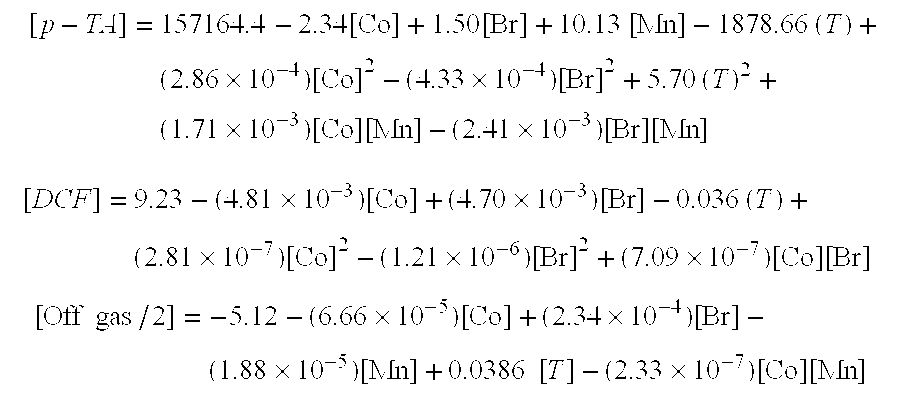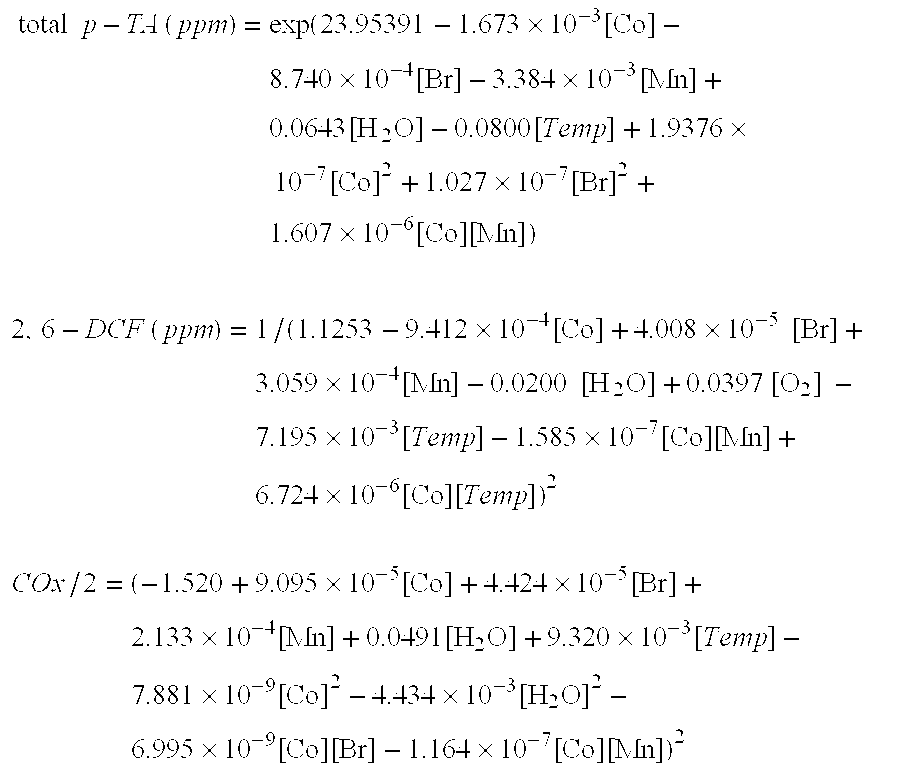Processes for producing terephthalic acid
- Summary
- Abstract
- Description
- Claims
- Application Information
AI Technical Summary
Benefits of technology
Problems solved by technology
Method used
Image
Examples
examples 1-30
[0069] In examples 1-30, oxidations of p-xylene to terephthalic acid were carried out in a pilot reactor system assembled around an agitated, hot-oil jacketed, 2-gallon, titanium reaction vessel. The gas dispersion type agitator within the reaction vessel can be rotated at various speeds. At about 1,500 revolutions per minute (rpm), the power draw of the agitator was approximately 210 watts. The pilot reactor system was equipped with means to control the pressure and temperature within the reaction vessel and to control the gas and liquid flow rates entering the reaction vessel.
[0070] para-Xylene was fed at an effectively steady rate of 2.64 moles per hour via a metering system. Catalyst feed solution was pumped from a catalyst feed tank into the reaction vessel at an effectively steady rate of 7.1 pounds per hour (3.2 kilogram per hour). Both para-xylene and catalyst feed solution were released into the reaction medium through a dip tube ending below the level of aerated slurry wi...
##ic examples 31-36
Prophetic Examples 31-36
[0083] The data presented in Tables 1 through 4 was used to develop a theoretical polynomial model for each response reported in the tables. These models were then used to predict conditions leading to low levels of DCF in the solid with low values for mol offgas / 2, as follows. [p-TA]=157164.4-2.34[Co]+1.50[Br]+10.13 [Mn]-1878.66 (T)+(2.86×10-4)[Co]2-(4.33×10-4)[Br]2+5.70 (T)2+(1.71×10-3)[Co][Mn]-(2.41×10-3)[Br][Mn][DCF]=9.23-(4.81×10-3)[Co]+(4.70×10-3)[Br]-0.036 (T)+(2.81×10-7)[Co]2-(1.21×10-6)[Br]2+(7.09×10-7)[Co][Br][Off gas / 2]=-5.12-(6.66×10-5)[Co]+(2.34×10-4)[Br]-(1.88×10-5)[Mn]+0.0386 [T]-(2.33×10-7)[Co][Mn]
[0084] Thus, Prophetic Examples 31-36 (Table 6) are carried out as set forth above with respect to Examples 1-30, the values in Table 6 being calculated values as just described.
TABLE 6Prophetic Examples leading to low levels of DCF.DCFp-TAPropheticTPwater[Co][Br][Mn]mol(ppm) in(ppm)Example(° C.)(psig)(%)ppmppm[...
examples 37-115
[0085] The oxidations of p-xylene described in examples 37 to 115 were carried out under conditions different from those used for Examples 1 through 30. Each reaction was performed in a 3-gal titanium agitated autoclave equipped with a means to control the pressure, temperature, gas flow, and a condenser system designed to remove a predetermined amount of condensed vapor from the process. Para-xylene was fed with a metering system at a rate of 330 g / h, and fresh catalyst solution was pumped from a feed tank into the autoclave at a rate of 3330 g / h. The gases exiting the reactor were continuously monitored for oxygen, carbon dioxide, and carbon monoxide with an in-line gas analyzer. The air feed rate was adjusted so as to maintain an oxygen concentration of that listed in the Tables. The level in the reactor was maintained at around 43% by operation of an automatic drain valve located in the bottom of the reactor. Reaction condensate was removed from the process at a rate of 2390 g / h...
PUM
| Property | Measurement | Unit |
|---|---|---|
| Temperature | aaaaa | aaaaa |
| Temperature | aaaaa | aaaaa |
| Temperature | aaaaa | aaaaa |
Abstract
Description
Claims
Application Information
 Login to View More
Login to View More - R&D
- Intellectual Property
- Life Sciences
- Materials
- Tech Scout
- Unparalleled Data Quality
- Higher Quality Content
- 60% Fewer Hallucinations
Browse by: Latest US Patents, China's latest patents, Technical Efficacy Thesaurus, Application Domain, Technology Topic, Popular Technical Reports.
© 2025 PatSnap. All rights reserved.Legal|Privacy policy|Modern Slavery Act Transparency Statement|Sitemap|About US| Contact US: help@patsnap.com



